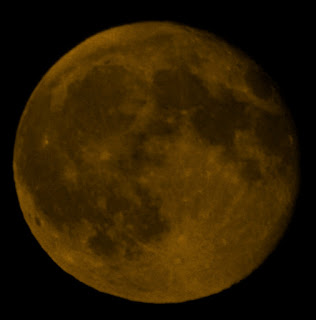June 30th 1600 GMT
June 29th 2155 GMT
June 27th 2150 GMT
I had a quick session with the DSLR. I took a set of full
moon shots, Jupiter’s moons and Saturn with the moon. The Moon photos did not work but I caught Jupiter with its moons.
June 27th 0640 GMT
The Sun looked very quiet in hydrogen alpha light.
June 26th 2150 GMT
I was unable to get the Bresser Electronic Eyepiece to work
at all, without crashing the computer! I resorted to using afocal photography
to capture the discs of Venus and Jupiter. I used the Mak and DSLR at 1.54m
focal length, ISO 6400 and 2/3 second exposure to capture Jupiter’s moons and
another try at a shorter exposure to capture the disc.
The first Jupiter was taken afocally and the second directly with the DSLR.
June 26th 0655 GMT
I checked the Sun in hydrogen alpha light early, as
temperatures were predicted to be uncomfortable later. The Sun seemed rather
quiet.
June 25th 1500 GMT
June 24th 2150 GMT
June 24th 1035 GMT
The Sun seemed quiet in hydrogen alpha light.
June 24th 0000 GMT
Conditions were quite poor but the best that they had been
following my early morning solar shoot the day before. Cloud was scattering
moonlight and Jupiter was nearby. By the time I was ready, Jupiter had
disappeared behind cloud! I took a few full disc frames of the Moon instead,
with my Mak and DSLR.
I then had a go at Jupiter, with some shorter exposures to
capture planetary detail and longer exposures to catch the moons. I did not
feel too hopeful about either.
I then tried to catch the Moon and Jupiter in the same frame
with just the DSLR.
Well, sort of but not that great.
Well, sort of but not that great.
I finally switched my attention to Alcor and Mizar, using my
Mak and DSLR with ISO 6400, 1.54m focal length and 2/3 second exposure.
June 23rd 0740 GMT
I checked the Sun in hydrogen alpha light. Visually, it
seemed more quiet than the day before. I took some full disc frames.
June 22nd 0740 GMT
June 21st 0940 GMT
As the Big Bear images were showing sunspots, I took some
full disc shots with my Mak and DSLR. Focal length was 1.54m, ISO 100 and
1/4000 second exposure.
June 20th 1920 GMT
June 15th 2300 GMT
I took some frames of Jupiter with its moons with my DSLR at
the usual settings.
June 14th 1225 GMT
I started off with the wrong eyepiece but proceeded to take some shots anyway. I changed to the right one and took some full disc shots that showed some activity. I processed the best full disc shot first.
June 12th 2200 GMT
I took my DSLR and Mak out for a quick shoot before bedtime.
It would have been better to use my Meade Electronic Eyepiece but I did not
want a long session, as I had work the next day.
I snapped Venus at 1.54m focal length, ISO 100 and 1/200
second exposure.
I tried a slightly longer exposure of 1/100 second for
Jupiter. It didn't work, as I didn't catch the cloud belts.
June 11th 1535 GMT
I took a few frames of the Sun in hydrogen alpha light and found some activity.
June 10th 0000 GMT
June 9th 0620 GMT
I processed another frame later.
June 6th 0920 GMT
June 3rd 0935 GMT
I checked the Sun in hydrogen alpha light. Although it was
quiet, I saw some albedo features.
June 2nd 2230 GMT
It was not a fantastically clear night but I went out, as I
did not have work the next day. I started off with the camera at 300mm focal
length, ISO 6400 and 2 seconds exposure. My targets were Jupiter and the area
around Antares.
The Jupiter shot was slightly out of focus but showed the moons and background sky well.
I then adjusted the camera to 70mm focal length, ISO6400 and
8 seconds exposure. Targets were Albireo, the centre of the cross in Cygnus,
Cassiopeia and another go at Antares.
Albireo was near the top of the frame.
Central Cygnus caught M29.
Cassiopeia turned out well, despite the conditions.
The Antares shot was swamped with cloud.
Albireo was near the top of the frame.
Central Cygnus caught M29.
Cassiopeia turned out well, despite the conditions.
The Antares shot was swamped with cloud.
June 2nd 1640 GMT
The Sun seemed quiet in hydrogen alpha light.













































